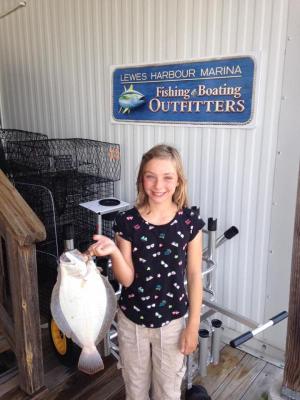The Delaware Division of Fish and Wildlife has announced a new Delaware Sport Fishing Tournament youth division for anglers 15 and under. All species currently in the tournament will be eligible for youth division awards in both the retain and release categories. Sizes will be smaller for the youth division.
As with the current tournament, all fish must be weighed in at Delaware Sport Fishing Tournament weigh stations, and release entries must be signed by a witness. There is no entry fee, and the citations will include a full-color illustration of the fish caught done by artist Duane Raver Jr., plus an award lapel pin. The certificate is suitable for framing.
All fish must be caught in a sporting manner on hook and line. While some of the youngest anglers may need a wee bit of assistance, the angler must do the job of hooking and landing the fish.
The reason for this youth division is to encourage young anglers to do more fishing. If we don’t get our kids interested in enjoying the outdoors, we face a pretty dark future.
To find out more about this tournament, search for Delaware Sport Fishing Tournament.
Fishing report
To quote one of Mr. Murphy’s Laws, “All constants are variable,” pretty much sums up the current fishing situation.
On Monday, Larry Weldin, Doug Elliott and I ventured out into the ocean in search of triggerfish. We headed south to the Fenwick wrecks only to find them already taken by boats that obviously had an earlier start. We could have anchored up alongside one of the other boats, but I hate it when someone does that to me, so I never do that to someone else.
Running back up the beach, we hit reef sites 10 then 9, finding only small ling and sea robins. A final stop at the Croaker Canyon in front of the Old Coast Guard Station produced absolutely nothing. The wind continued to increase, and while getting beat up while catching fish is one thing, getting beat up while catching nothing is something else. We headed to the dock around 12:30 p.m.
Once back home, I checked with one of the captains that had fished the Fenwick wrecks and found he had caught the same fish we did, ling and sea robins. We both blamed our bad luck on the boats that picked the wrecks and reefs clean over the weekend.
In the Delaware Bay, kings have been caught on reef sites 6, 7 and 8 along with the occasional flounder. Bloodworms are good for the kings, with minnows and Gulp! the prime baits for flounder. Triggerfish are on the same structure and will eat small bits of clam on a small hook.
The fishing pier at Cape Henlopen State Park is seeing a few more keeper flounder caught on live minnows fished tight to the pilings. Triggerfish have been caught around the pilings, with the best action on slack current.
The slot season in Delaware Bay for rockfish has not produced many keepers unless those who are having success are keeping it to themselves. Drifting eels around the three bridges in Lewes has produced the desired results in the past, but I have not heard much so far this year.
Offshore fishing has settled down a little from what it was a week ago. The canyons are still producing good numbers of yellowfin tuna plus some dolphin and marlin, but now the bluefins have moved to the inshore lumps. Chunking is getting started at the lumps, and once it takes hold trolling will be more difficult. The best catches from the lumps to the deep have been predawn or at nightfall. Overnight trips are expensive, but they bring in the most fish.
The surf is still seeing good numbers of kings on bloodworms. Other than that, it is sharks, skates and rays. I am not hearing much about night fishing for big sand bar or sand tiger sharks from the beach. Either the people who have been doing this finally got smart (doubtful) or they decided to keep their activities on the quiet.
Indian River Inlet has seen some rockfish caught at night on sand fleas or bucktails. During the day, triggerfish and sheepshead are taken on the same bait.
Last Wednesday, I gave the inlet a try at dusk on incoming water at the top of the tide. There were only a few folks fishing, and I saw one blue caught on a white bucktail. My sand fleas drew light taps from small fish.
The Back Bays have produced a few more flounder. Live minnows, Gulp! and bucktails have accounted for most of these fish. The same areas have seen the best action: the VFW Slough, the south side of the inlet along the campground, and Massey’s Ditch.























































